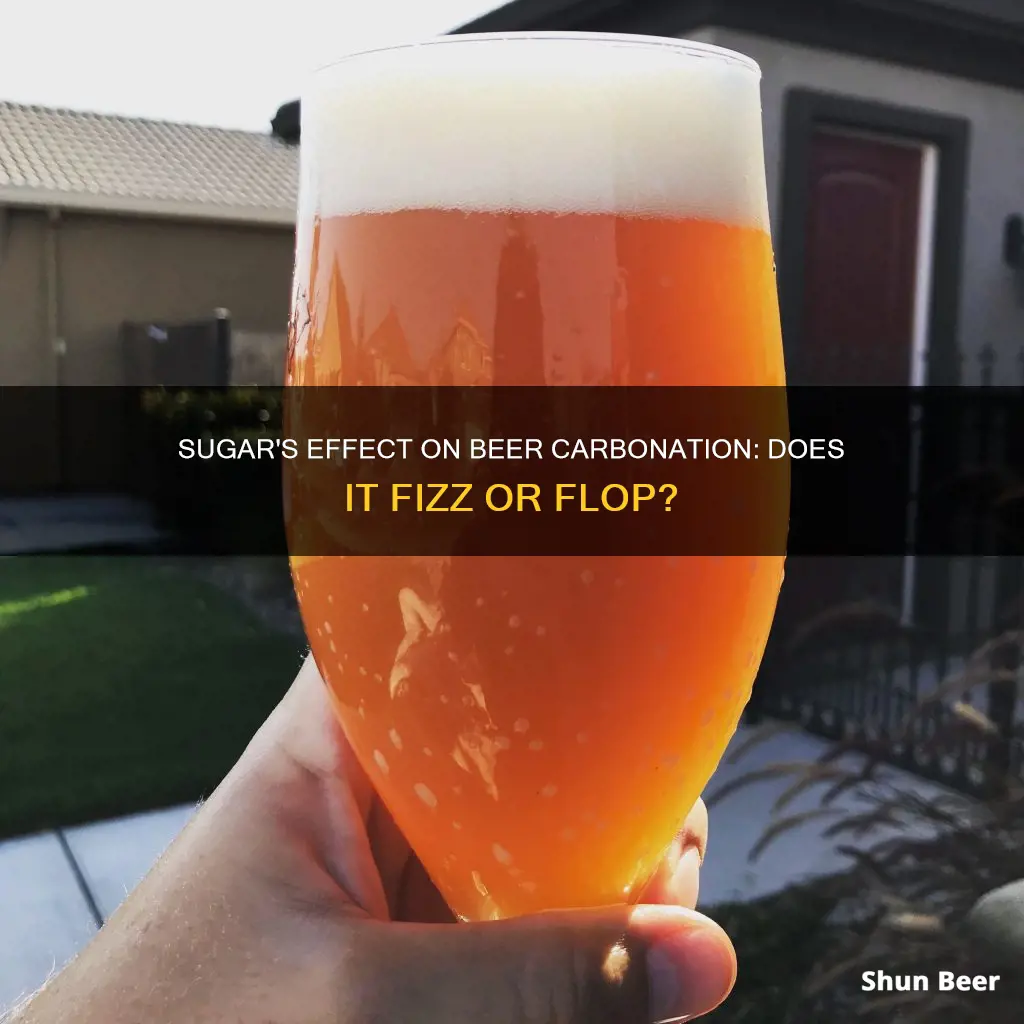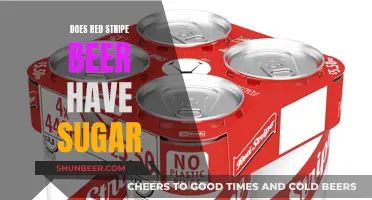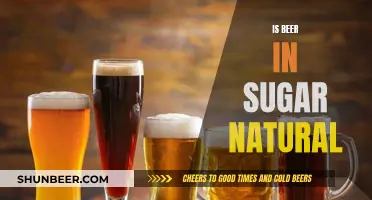
Carbonation is an important part of the beer-making process, and it's something that needs to be done for every beer. Adding sugar is a popular way to carbonate beer, and it's a straightforward option for first-time or novice home brewers. The sugar is food for the yeast, which creates carbon dioxide and adds fizz to the beer. There are a few ways to add priming sugar to beer, including using a syringe, adding it directly to the fermenter, or dissolving it in a pan of water and then pouring it into a bottling bucket.
| Characteristics | Values |
|---|---|
| When to add priming sugar | Before filling the bottles |
| Why add priming sugar before filling the bottles | Easier to handle the bottle and avoids splashes of beer which can lead to oxygenation |
| How to add priming sugar | Use a large syringe to add priming sugar solution directly to each bottle; add priming sugar directly to the fermenter and agitate to mix; add dissolved priming sugar to a second vessel and then rack the beer into it prior to bottling |
| How much priming sugar to use | Depends on the type of beer, the amount of beer, the amount of carbon dioxide already in the beer, and the desired level of carbonation |
| Types of priming sugar | Corn sugar (dextrose), table sugar (sucrose), dry malt extract (DME), and honey |
What You'll Learn

How to add priming sugar to bottled beer for carbonation
Adding sugar to beer is a common practice for homebrewers to carbonate their beer. The process is called "priming" and is a crucial step in the beer-making process. Here is a step-by-step guide on how to add priming sugar to bottled beer for carbonation:
Step 1: Prepare the Bottles
Make sure you have enough bottles for your batch. For a traditional five-gallon batch, you will need two cases (48) of 12-ounce bottles. Clean and sanitise each bottle using a no-rinse brewing sanitizer like Star-San. If you are reusing old bottles, inspect them for mould.
Step 2: Prepare the Bottle Caps
Sanitise the bottle caps you will be using. If you are using Grolsch-style bottles, you can sanitise the rubber seals in the same way as traditional bottle caps.
Step 3: Prepare the Priming Sugar
To ensure the sugar dissolves evenly, boil about two cups of water and dissolve your chosen priming sugar in it. Boiling sanitises the water and allows you to use less water as more sugar can be dissolved in hot water. Pour the solution into your brew and mix. Be careful not to stir up any sediment at the bottom of your bucket.
Step 4: Bottle the Beer
When combining the beer and priming sugar, avoid splashing as this can introduce oxygen and affect the flavour. You do not need to stir; the swirling motion of pouring the beer into the bottling bucket will be enough to mix the solution. If you do not have a bottling bucket, you can pour the priming solution into your fermenter and gently stir. Allow any sediment to settle for 15-30 minutes before filling your bottles.
Additional Tips:
- It is recommended to add your priming sugar before filling your bottles. This makes it easier to handle the bottles when they are empty, and reduces the risk of oxygenation.
- Do not shake your bottles as this will create oxygen in the beer and lead to off-flavours.
- Priming sugar can be added directly to each bottle using a large syringe, or added to the fermenter and agitated to mix.
- Corn sugar, table sugar, and dry malt extract are the three most popular types of sugar used for priming solutions.
Sweetening Carbonated Beer: Sugar Quantity for 16 Oz
You may want to see also

The best types of sugar for priming beer
Adding priming sugar to beer is a common practice among homebrewers to improve the taste, aroma, and mouthfeel of the beer. It is also done to ensure carbonation and to increase alcohol levels.
When it comes to the types of sugar that can be used for priming beer, pretty much any sugar type can be used, although some types of sugar will benefit your beer more than others. Simple sugars, such as normal white table sugar or sucrose, can be used as priming sugar, but they won't add any flavour or aroma to your beer. On the other hand, using more "natural" sugars, such as dark brown sugar or honey, will give your beer a nicer aroma and amplified taste, in addition to the desired fizz.
- Corn Sugar (Dextrose): Corn sugar is the most popular bottling sugar and is often recommended for new homebrewers. It is cheap, leaves no added flavour, and does not influence the taste of the finished beer. It is also very soluble and easy for the yeast to digest.
- White Sugar (Sucrose): Also known as table sugar, this is the most basic of priming sugars. It is appealing due to its low cost and easy availability. Similar to corn sugar, it does not add any flavour to the beer, so it can be used for any kind.
- Belgian Candi Syrup: This is an invert sugar that comes in different colours. The flavour increases as the colour gets darker. It is not traditionally used but can be used to enhance the flavour of Belgian beers.
- Belgian Soft Candi Sugar: Another type of invert sugar that comes in blonde and brown versions. The blonde version adds very little colour or flavour, while the brown version has a more pronounced impact on the beer.
- Black Treacle: A type of molasses that is very dark and leaves a lot of flavour. It has more caramel flavours than regular molasses.
- Brown Sugar: Brown sugar comes in light and dark varieties, with the flavour increasing from light to dark. It is a partially refined sugar with molasses added. Muscovado, a type of unrefined brown sugar, has a much greater depth of character.
- Honey: The flavour of honey depends on the variety. Lighter honeys like clover will add no character, while darker ones like buckwheat will add a lot of flavour. Varietal honeys, like orange blossom, can give a slight hint of their character to the finished beer. Honey is a good option for meads or honey wines, but it can be difficult to prime with due to the varying concentrations.
- Maple Syrup: Maple syrup will add more flavour as it gets darker. The darker varieties are better for priming beer, but they can dilute the beer quite a bit.
- Dry Malt Extract (DME): This is an unfermented wort that has been dried into powder form. It helps add flavour and body to the beer and may result in finer bubbles compared to sugar. However, priming with DME can take longer, which may initially make the bubbles appear smaller.
Best Low-Sugar Beers: The Sweetness Spectrum
You may want to see also

How much priming sugar is needed to carbonate beer
The amount of priming sugar needed to carbonate beer depends on several factors, including the type of sugar used, the volume of beer, the desired level of carbonation, and the fermentation temperature.
Priming sugar is added to beer during the bottling process to create carbonation and enhance the flavour. Common types of priming sugar include corn sugar (dextrose), table sugar (sucrose), and dry malt extract (DME). The amount of sugar required will vary depending on the type of sugar used, as each has a different volume and fermentability. For example, the standard amount of corn sugar used for priming is 3/4 cups (6 ounces or 113 grams) for every 5 gallons of beer, while for table sugar, the standard amount is 2/3 cup (5.3 ounces or 150 grams) for the same volume of beer.
To determine the exact amount of priming sugar needed, brewers can use a priming sugar calculator or formula. These tools take into account the residual carbonation present in the beer after fermentation, the target carbonation level for the specific beer style, and the volume of the brew. By inputting these values, brewers can calculate the precise amount of priming sugar required to achieve the desired carbonation level.
Additionally, the method of adding priming sugar to the beer can vary. Some common methods include using a syringe to add the priming sugar solution directly to each bottle, adding the priming sugar directly to the fermenter and agitating it, or dissolving the priming sugar in a separate vessel and then racking the beer into it before bottling. Each method has its advantages and disadvantages in terms of sanitation, ease of use, and the risk of compromising the beer's flavour.
Beer and Blood Sugar: A Dangerous Mix?
You may want to see also

How to calculate the amount of priming sugar needed for a batch of beer
Adding sugar is a common way to carbonate beer, especially for first-time or novice home brewers. This process is called "priming". The amount of priming sugar needed depends on the volume of beer in the batch, the desired level of carbonation, and the type of sugar used.
There are several online priming sugar calculators available that can help you determine the right amount of sugar for your batch. These calculators take into account factors such as the fermentation temperature, the CO2 volume required, and the specific style of beer you are brewing.
To use a priming sugar calculator, you will need to input information such as the type of sugar you are using, the volume of beer in your batch, and your desired level of carbonation. The calculator will then provide you with the amount of sugar needed in grams or ounces. It is recommended to add the sugar by weight rather than volume for more accurate measurements.
There are also manual methods to calculate the amount of priming sugar needed. One way is to use a large syringe to add a priming sugar solution directly to each bottle. This method ensures equal sugar quantities in each bottle but requires careful sanitation to avoid compromising the beer. Another method is to add the priming sugar directly to the fermenter and agitate it to mix thoroughly. However, this can stir up the yeast, which can contribute to off-flavours in the beer.
By using either an online calculator or a manual method, you can ensure that your beer achieves the desired level of carbonation without compromising the flavour or quality.
Cider Beers: Sugar Content and Health Considerations
You may want to see also

The pros and cons of using carbonation tablets
Carbonation tablets are a convenient way to carbonate beer, offering several advantages over traditional methods of adding sugar to beer. Here are the pros and cons of using carbonation tablets:
Pros:
- Ease of use: Carbonation tablets are easy to use, as you simply place a tablet into your beer bottle without any need for mixing or measuring. This simplifies the bottling process, making it quicker and less messy.
- Speed: They save time, especially if you're busy and have limited time for brewing. By eliminating the need for precise sugar measurements, they streamline the bottling stage.
- Consistency: Carbonation tablets help avoid miscalculations that can lead to over-carbonation or under-carbonation. Each bottle receives a precise dose of sugar, ensuring consistent carbonation levels.
- Sanitation: They reduce the number of items that need to be cleaned and sanitized. You don't need a separate mixing bucket, which means less equipment to wash.
- Safety: Carbonation tablets reduce the risk of "beer bombs," where excessive carbon dioxide pressure can cause bottles to explode.
- Dissolvability: Tablets made with dextrose dissolve quickly, ensuring that all the sugar is absorbed and used for proper carbonation.
Cons:
- Fine-tuning carbonation: It can be challenging to fine-tune the amount of carbonation in your beer with tablets. If you want specific carbonation levels for different beer styles, you may need to cut the tablets into smaller pieces, negating some of the convenience.
- Cost: Carbonation tablets are slightly more expensive than using table sugar, although this may be offset by the value of your time.
- Alcohol content: The in-bottle fermentation caused by carbonation tablets can increase the alcohol content of your beer by up to 0.2%, which may be undesirable for certain brews.
Beer and Blood Sugar: What's the Connection?
You may want to see also
Frequently asked questions
Priming sugar is any fermentable sugar that is added to beer to carbonate it and give it fizz.
Corn sugars, table sugar, and dry malt extract.
This depends on how much beer you have made, how much carbon dioxide is already in the beer, and how much carbonation you want to add.
The best way is to create a priming sugar solution by boiling water and dissolving the sugar in it. Then, pour it into your bottling bucket and siphon the beer from the fermenter into the bucket.
Yes, but they are expensive and give you less control over carbonation.







